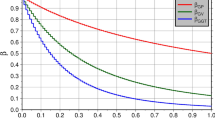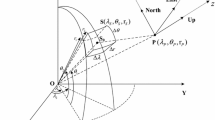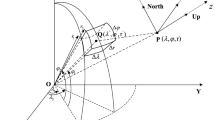Abstract
We developed an accurate method to compute the gravitational field of a tesseroid. The method numerically integrates a surface integral representation of the gravitational potential of the tesseroid by conditionally splitting its line integration intervals and by using the double exponential quadrature rule. Then, it evaluates the gravitational acceleration vector and the gravity gradient tensor by numerically differentiating the numerically integrated potential. The numerical differentiation is conducted by appropriately switching the central and the single-sided second-order difference formulas with a suitable choice of the test argument displacement. If necessary, the new method is extended to the case of a general tesseroid with the variable density profile, the variable surface height functions, and/or the variable intervals in longitude or in latitude. The new method is capable of computing the gravitational field of the tesseroid independently on the location of the evaluation point, namely whether outside, near the surface of, on the surface of, or inside the tesseroid. The achievable precision is 14–15 digits for the potential, 9–11 digits for the acceleration vector, and 6–8 digits for the gradient tensor in the double precision environment. The correct digits are roughly doubled if employing the quadruple precision computation. The new method provides a reliable procedure to compute the topographic gravitational field, especially that near, on, and below the surface. Also, it could potentially serve as a sure reference to complement and elaborate the existing approaches using the Gauss–Legendre quadrature or other standard methods of numerical integration.














Similar content being viewed by others
References
Anderson EG (1976) The effect of topography on solutions of Stokes’ problem. Unisurv S-14 Report, School of Surveying. University of New South Wales, Kensington
Bailey DH, Jeyabalan K, Li XS (2005) A comparison of three high-precision quadrature schemes. Exp Math 14:317–329
Conway JT (2015) Analytical solution from vector potentials for the gravitational field of a general polyhedron. Celest Mech Dyn Astron 121:17–38
D’Urso MG (2014) Analytical computation of gravity effects for polyhedral bodies. J Geod 88:13–29
Dziewonski AM, Anderson DL (1981) Preliminary reference Earth model. Phys Earth Planet Inter 25:297–356
Fukushima T (2014) Computation of a general integral of Fermi–Dirac distribution by McDougall–Stoner method. Appl Math Comput 238:485–510
Fukushima T (2016a) Numerical computation of gravitational field of infinitely thin axisymmetric disc with arbitrary surface mass density profile and its application to preliminary study of rotation curve of M33. Mon Not R Astron Soc 456:3702–3714
Fukushima T (2016b) Mosaic tile model to compute gravitational field for infinitely thin non axisymmetric objects and its application to preliminary analysis of gravitational field of M74. Mon Not R Astron Soc 459:3825–3860
Fukushima T (2016c) Numerical computation of gravitational field for general axisymmetric objects. Mon Not R Astron Soc 462:2138–2176
Fukushima T (2016d) Numerical integration of gravitational field for general three-dimensional objects and its application to gravitational study of grand design spiral arm structure. Mon Not R Astron Soc 463:1500–1517
Fukushima T (2017a) Numerical computation of electromagnetic field for general static and axisymmetric current distribution. Comput Phys Commun 221:109–117
Fukushima T (2017b) Precise and fast computation of gravitational field of general finite body and its application to gravitational study of asteroid Eros. Astron J 154:145
Garcia-Abdeslem J (2005) Gravitational attraction of a rectangular prism with density varying with depth following a cubic polynomial. Geophysics 70:J39–J42
Grombein T, Heck B, Seitz K (2013) Optimized formulae for the gravitational field of a tesseroid. J Geod 87:645–660
Heck B, Seitz K (2007) A comparison of the tesseroid, prism and point-mass approaches for mass reductions in gravity field modelling. J Geod 81:121–136
Heiskanen WA, Moritz H (1967) Physical geodesy. Freeman, San Francisco
Hirt C, Kuhn M (2014) Band-limited topographic mass distribution generates full-spectrum gravity field: gravity forward modeling in the spectral and spatial domains revisited. J Geophys Res Solid Earth 119:3646–3661
Hirt C, Rexer M (2015) Earth 2014: 1 arc-min shape, topography, bedrock and ice-sheet models-available as gridded data and degree-10,800 spherical harmonics. Int J Appl Earth Obs Geoinf 39:103–112
Jekeli C (2007) Potential theory and static gravity field of the earth. In: Schubert G (ed) Treatise on geophysics, vol 3, 2nd edn. Elsevier, Amsterdam
Karcol R (2011) Gravitational attraction and potential of spherical shell with radially dependent density. Stud Geophys Geod 55:21–34
Kellogg OD (1929) Foundations of potential theory. Springer, Berlin
Kennett BLN (1998) On the density distribution within the Earth. Geophys J Int 132:374–382
Klees R, Lehmann R (1998) Calculation of strongly singular and hypersingular surface integrals. J Geod 72:530–546
Kuhn M, Hirt C (2016) Topographic gravitational potential up to second-order derivatives: an examination of approximation errors caused by rock-equivalent topography (RET). J Geod 90:883–902
Laske G, Masters G, Ma Z, Pasyanos M (2013) Update on CRUST1.0—a 1-degree Global Model of Earth’s Crust. In: Geophysical research abstracts, vol 15, Abstract EGU2013-2658
MacMillan WD (1930) The theory of the potential. McGraw-Hill, New York
Martinec Z (1988) Boundary value problems for gravimetric determination of a precise geoid. Springer, Berlin
Mori H (1985) Quadrature formulae obtained by variable transformation and DE rule. J Comput Appl Math 12&13:119–130
Nagy D, Papp G, Benedek J (2000) The gravitational potential and its derivatives for the prism. J Geod 74:552–560
Novak P, Grafarend EW (2005) Ellipsoidal representation of the topographical potential and its vertical gradient. J Geod 78:691–706
Press WH, Teukolsky SA, Vetterling WT, Flannery BP (2007) Numerical recipes: the art of scientific computing, 3rd edn. Cambridge University Press, Cambridge
Roussel C, Verdun J, Cali J, Masson F (2015) Complete gravity field of an ellipsoidal prism by Gauss–Legendre quadrature. Geophys J Int 203:2220–2236
Smith DA, Robertson DS, Milbert DG (2001) Gravitational attraction of local crustal masses in spherical coordinates. J Geod 74:783–795
Stacey FD, Davis PM (2008) Physics of the Earth, 4th edn. Cambridge University Press, Cambridge
Tachikawa T, Hato M, Kaku M, Iwasaki A (2011) Characteristics of ASTER GDEM version 2. In: Proceedings on IEEE international geoscience and remote sensing symposium, pp 3657–3660
Takahashi H, Mori H (1973) Quadrature formulae obtained by variable transformation. Numer Math 21:206–219
Takahashi H, Mori H (1974) Double exponential formulae for numerical integration. Publ RIMS Kyoto Univ 9:721–741
Tscherning CC (1976) Computation of the second-order derivatives of the normal potential based on the representation by a Legendre series. Manuscr Geod 1:71–92
Uieda L, Barbosa VCF, Braitenberg C (2016) Tesseroids: forward-modeling gravitational fields in spherical coordinates. Geophysics 81:F41–F48
Vanicek P, Krakiwsky EJ (1982) Geodesy: the concepts. North-Holland Publishing Company, Amsterdam
Waldvogel J (1979) The Newtonian potential of homogeneous polyhedra. J Appl Math Phys (ZAMP) 30:388–398
Wild-Pfeiffer F (2008) A comparison of different mass elements for use in gravity gradiometry. J Geod 82:637–653
Wu L (2016) Efficient modelling of gravity effects due to topographic masses using the Gauss—FFT method. Geophys J Int 205:160–178
Yu Y, Baoyin H (2015) Modeling of migrating grains on asteroids surface. Astrophys Space Sci 355:43–56
Acknowledgements
The author appreciates valuable suggestions and fruitful comments by Prof. Uieda and two anonymous referees to improve the quality of the article.
Author information
Authors and Affiliations
Corresponding author
Electronic supplementary material
Below is the link to the electronic supplementary material.
Appendices
Appendices
Kernel function
The kernel function used in the main text is that of degree 0 introduced in our previous work (Fukushima 2017b). After omitting the argument dependence for simplicity, and choosing the unit system such that \(G = \rho = 1\), we write it compactly as
where Q is a quantity defined as
Here \(\sigma \), C, and other quantities are computed by the following sequence. First of all, we define the surface heights of the tesseroid not by a pair of \(H_\mathrm{T}\) and \(H_\mathrm{B}\) but by \(H_\mathrm{B}\) and the thickness, \(\varDelta H \equiv H_\mathrm{T} - H_\mathrm{B}\). Then, we compute \(H_\mathrm{T}\) and a constant specific to the tesseroid only as
Next, prior to the whole process of the numerical integration, we calculate some parameters from the given coordinates of the evaluation point, \((\varPhi , \varLambda , H)\), as
Thirdly, in the outer integration, namely that with respect to \(\xi \), we evaluate the following \(\eta \)-independent variables beforehand:
Fourthly, in the inner integration, namely that with respect to \(\eta \), the variables are computed from the input value of \(\eta \) in the order of the evaluation sequence as
Finally, Q is computed from these by using Eq. (59), and then, K is obtained by evaluating Eq. (58).
In the above, \(\mathtt{log1p}(x)\) is a special logarithm function defined as
The function is available from the standard mathematical function library of C, C++, and MATLAB but not of Fortran. A double precision implementation in Fortran, \(\mathtt{dlog1p}\), is already provided in Appendix D of Fukushima (2017b). Its quadruple precision extension is provided in the ESM.
The above expression of the kernel function is significantly different from those provided in the geodetic literature (Heck and Seitz 2007; Wild-Pfeiffer 2008). In particular, we conditionally evaluate Q in two different forms. They are mathematically equivalent with each other but computationally different if round-off errors are taken into consideration. The introduction of a switch is required so as to avoid unnecessary loss of information due to cancelations. At any rate, the rewriting of the kernel function into a cancelation-free form is the main trick to guarantee the proper convergence of the Romberg sequence adopted in the double exponential quadrature rule.
Double exponential quadrature rule
Here we present a brief summary of the double exponential (DE) quadrature rule for a line integral with a finite integration interval (Takahashi and Mori 1973, 1974). The variations for other type of integration interval are explained in Press et al. (2007, Sect. 4.5).
Let us consider the numerical evaluation of a general line integral expressed as
First, we transform this finite interval integral into an infinite interval integral by the integration variable transformation as
where t is a new integration variable related to x as
and therefore, the transformed integrand, F(t), is written as
where
Next, we approximate the transformed integral, \(I^*\), by truncating the infinite integration interval as
where \(h_\mathrm{max}\) is a certain numerical value such as 2.75 to 6.5 (Fukushima 2017b, Appendix C). Finally, we numerically evaluate the truncated integral, J, by the Romberg method (Press et al. 2007, Sect. 4.3), namely the Richardson extrapolation applied to the trapezoidal rule.
The method is called ‘double exponential’ because the weight factor of the transformed integrand, \(\psi '(t)\), decreases like a doubly exponential function as
Its decreasing manner is so rapid that any kind of blowing-up but integrable singularity of the original integrand, f(x), can be effectively suppressed as long as the location of the singularity coincides with one of the end points, \(x=a\) or \(x=b\), and therefore, \(t=-\,\infty \) or \(t=+\,\infty \) (Mori 1985). Thus, the DE rule is one of rare quadrature rules which can evaluate the improper but integrable integrals in a reliable manner.
Also, the convergence of the Romberg sequence adopted in the DE rule is quite rapid. Indeed, it converges exponentially in many cases (Press et al. 2007, Sect. 4.5.1). This results a very high cost performance of the DE rule (Bailey et al. 2005). See also Fukushima (2017b, Appendix C).
Another good feature of the DE rule is its adaptive nature inherited from that of the Romberg method. Consequently, the end users do not have to worry about setting many method-specific parameters except the only one: the input relative error tolerance, \(\delta \). For example, if one wants an integral value with the 10 digit precision, one may simply set \(\delta =10^{-10}\) and call the computer program of the DE rule. Then, the program automatically takes care of the number of trial integrations by the trapezoidal rule.
However, there is a pitfall to be warned. We have experienced that, if the integrand can not be very precisely computed near the endpoints, the convergence of the Romberg sequence in the DE rule degrades significantly, and thus ruins the appropriateness of the DE rule as a whole. In many cases, naive transformations from f(x) to \(F(\psi (t))\) suffer from the information loss due to cancelations of similar terms. Therefore, it is a key point to examine the chance of cancelation in the process of the integrand transformation and, if necessary, to rewrite the transformed integrand into a cancelation-free form as we did for the kernel function, K, in Appendix A.
At any rate, as far as we know, the DE rule is an all-purpose quadrature rule with a great cost performance and an ease of use. A double precision implementation of the DE rule as a Fortran subroutine is found in Fukushima (2017b, Appendix C). Its quadruple precision extension is given in the ESM.
Second-order finite difference formulae
1.1 First-order derivative
Let us consider the second-order finite difference formulae to compute numerically the partial derivatives of a given function. We begin with the case when the function is of a single variable as f(t). If the function is analytic in the neighborhood of the given argument, t, then we use the central difference formula written as
This formula is of the second order. Namely, its relative error is roughly in proportion to \((\varDelta t)^2\) as
On the other hand, if f(t) is not fully analytic in the closed interval, \(\left[ t-\varDelta t, t+\varDelta t \right] \), say if the function has a discontinuity, a kink, or a singularity within the interval, the above formula can not be used. In the case of the gravitational potential of a tesseroid, the surrounding boundaries of the tesseroid correspond to the location of such non-analyticity. At any rate, in these cases, we obtain a second-order formula by using only the single-sided values as
where the double sign must be appropriately chosen depending on the analyticity of f(t). More specifically speaking, we have to choose the positive sign \((+)\) if f(t) is analytic in the interval \([t, t+2\varDelta t]\) and the negative sign \((-)\) if f(t) is analytic in the interval \([t-2\varDelta t, t]\). In any case, the relative error of the single-sided formula is estimated as
Its magnitude is twice as large as that of the central difference formula.
1.2 Second-order derivative
Let us move to the second-order derivative. As long as the function is sufficiently smooth, we recommend the usage of the central difference formula expressed as
This is of the second order since
Meanwhile, if f(t) is not analytic in the interval, \([ t-\varDelta t, t+\varDelta t ]\), then we use the second-order single-sided formula as
where the double sign must be appropriately chosen depending on the analyticity of f(t) again. Its relative error is estimated as
the magnitude of which is 11 times larger than that of the central difference formula. We must say that this 1 digit loss is a significant degradation.
1.3 Extension to multiple variable functions
Let us extend the formulae in the previous subsections to the case when the function is dependent on multiple variables. For simplicity, we assume that the function is a two-argument functions as f(u, v). Then, if the function is sufficiently smooth around the evaluation point such that the central difference formulae are applicable, the first and the non-mixed second-order partial derivatives are approximated in the same manner as in the previous subsections, respectively. Also, the mixed second-order partial derivatives are obtained by separately applying the first-order central difference formula to the both variables as
On the other hand, if f(u, v) is analytic not with respect to u but with respect to v, then the mixed second-order partial derivatives are computed by mixing the single-sided first-order difference formula with respect to u and the central first-order difference formula with respect to v as
where the double sign must be appropriately chosen depending on the situation. We omit the case when f(u, v) is analytic not with respect to v but with respect to u because the recipe is the same as in the above after exchanging the role of u and v. Finally, if f(u, v) is not analytic with respect to both of u and v, then the mixed second-order partial derivatives are approximated by repeatedly using the single-sided first-order difference formulae as
where the sign factors \(\epsilon _u = \pm \, 1\) and \(\epsilon _v = \pm \, 1\) must be appropriately chosen depending on the situation.
Rights and permissions
About this article
Cite this article
Fukushima, T. Accurate computation of gravitational field of a tesseroid. J Geod 92, 1371–1386 (2018). https://doi.org/10.1007/s00190-018-1126-2
Received:
Accepted:
Published:
Issue Date:
DOI: https://doi.org/10.1007/s00190-018-1126-2




